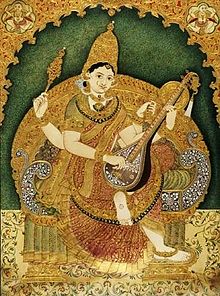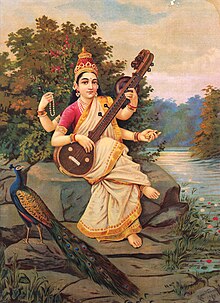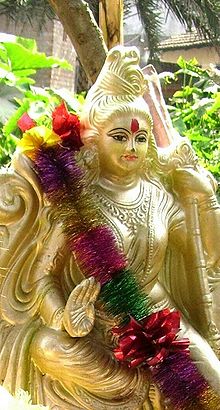Saraswati

Saraswati (Sanskrit: सरस्वती, Sarasvatī) is the Hindu goddess of knowledge, music, art, wisdom and nature. She is a part of the trinity of Saraswati, Lakshmi and Parvati. All the three forms help the trinity of Brahma, Vishnu and Shiva in the creation, maintenance and destruction of the Universe. The Goddess is also revered by believers of the Jain religion of west and central India. She is known in Burmese as Thurathadi or Tipitaka Medaw , in Chinese as Biàncáitiān (辯才天), in Japanese as Benzaiten (弁才天/弁財天) and in Thai as Surasawadee (สุรัสวดี).
Quotes
[edit]- Sarasvati, Hindu goddess of learning and the arts, especially music. First appearing as the personification of the sacred river Sarasvati and also identified with Vac, the goddess of speech, she is later named the consort, daughter, or granddaughter of the god Brahma. She is regarded as the patroness of art, music, and letters and as the inventor of the Sanskrit language. She is usually represented as riding on a goose of pure white that is able to undertake long flights and holding a lute and a manuscript or book. In modern times her mount has frequently been represented as a swan.
- The Editors of Encyclopædia Britannica in: Sarasvati Alternate title: Ardvī Sūrā, Encyclopædia Britannica, 16 December 2013
- Sarasvati is worshipped at the advent of spring (January–February), when her image is taken out in jubilant procession, but she is also invoked perennially and at examination times by students and by artists and performers of all kinds. Sarasvati is also popular in Jain and Buddhist mythology.
- The Editors of Encyclopædia Britannica in: "Sarasvati Alternate title: Ardvī Sūrā"
- For obstacles in education and defect in speech Saraswati Mantra as detailed in the Vedas, and believers in tantra should perform Neel Saraswati Mantra and stotra- these devices will usher in general well being.
- Dr. Bhojraj Dwivedi in: Astrology and Wealth, Diamond Pocket Books (P) Ltd., 2000, p.139

- Ganesha is frequently depicted with Saraswati, the Goddess of learning and music, and Lakshmi, the Goddess of wealth and prosperity. Since Ganesha is associated with similar attributes as the goddesses, many devotees believe that they are his wives in previous incarnations. This assumption is reinforced by their worship along with Ganesha, especially during Diwali. But no myths support this notion. The deities are worshiped together simply because they represent similar goals.
- Royina Grewal in:The Book of Ganesha, Penguin Books India, 2009, p. 64
- Saraswati is also said to have had her origin from the god Vishnu... Her association with Vishnu makes her the co-wife of Laksmi in many myths. In this relationship Saraswati for the most part represents spiritual, ascetic, or religious goals and values, whereas Laksmi represents worldly well-being as manifest in wealth, material power, and fertility.
- David Kinsley in: Hindu Goddesses: Visions of the Divine Feminine in the Hindu Religious Tradition, Motilal Banarsidass Publ., 1 January 1998, p. 58
- ...Purusha was personified as Brahma, Vishnu and Shiva while Prakriti was personified as Saraswati, Lakshmi and Shakti.

- There isn't a Hindu student who has not been encouraged to offer prayer to Goddess Saraswati especially during the school/college term. Goddess Saraswati is the consort of Brahma, the creator, and is worshipped as the Goddess of learning, wisdom, speech and music. Saraswati is worshipped regularly in the Fall during Navaratri, Hindus of Bengali tradition worship her during the Spring season.
- Dr. A. V. Srinivasan in: How to Conduct Puja to Saraswati, Primedia E-launch LLC, p. 10
- Roman Alphabet:
Prayer: yaakundendu tushaarahaara dhavalaa yaashubhra vastraanvitaa
yaaveenaa varadanda manditakaraa yaashveta padmaasanaa
yaabrahmaacyuta shankara prabrtibhir devai:sadaa pujitaa saamaam paatu
bhagavatee nishsesha jaadhyapahaa. - English translation: May that Saraswati whose complexion is as fair as kunda flower, the moon, snow, and pearl necklace, who wears spotless garments, whose hand adorns the veena, who is seated on a white lotus, who is constantly worshiped by Brahma, Vishnu, Shiva, who destroys laziness forever, May that goddess protect us.
- Hymn for Saraswati in:Dr. A. V. Srinivasan in: "How to Conduct Puja to Saraswati", p. 13
- In the Hindu practice of praying upon first waking up in the morning, the shloka recited includes Saraswati as described below:
- Roman Alphbet:
Prayer:
Karaagre Vasate Lakshmi,
Kara Madhye Saraswati,
Kara Muuley Stitha Gowri..
Prabhahate Kara Darshanam
extracted from: Yoga Mantra Collection of Ancient India, silambam.asia - At the tip of hand resides Lakshmi and at the center Saraswati
And at the base of palm resides Shakti
Thus we should view our palms in the morning.
which later removing Gowri (Shakti energy) one of three shaktis from Shakta and Shaiva version adopted into Vaishnavism version:
- Roman Alphbet:
Prayer:
karaagre vasate,
Lakshmi Karamadhye Saraswati
Karamuletu Govindaha
Prabhaate Karadarshanam - At the tip of hand resides Lakshmi and at the center Saraswati
And at the base resides Govinda (also known as Krishna)
Thus we should view our palms in the morning.- Hymn for Saraswati in:Dr. A. V. Srinivasan in: "How to Conduct Puja to Saraswati", p. 99
- Roman Alphbet:
Prayer:Saraswathi Namasthubhyam,
Varadey Kaamarupinee!
Vidhyarambham Karishyami,
Sidhir Bhavathu Mey Sada - English translation: Salutations to Saraswati capable of granting my prayers
I shall begin my learning and may you grant me success always- Hymn for Saraswati in:Dr. A. V. Srinivasan in: "How to Conduct Puja to Saraswati", p.99

- In worship of the gods, you must of course use images. But you can change these. Kali need not always be in one position. Encourage your girls to think of new ways of picturing Her. Have a hundred different conceptions of Saraswati. Let them draw and model and paint their own ideas
- The grace of both Lakshmi (goddess of fortune) and Sarasvati (goddess of learning) now shines on the peoples of the Western countries
Sarasvatī, Riverine Goddess of Knowledge: From the Manuscript-carrying Vīṇā-player to the Weapon-wielding Defender of the Dharma
[edit]


Catherine Ludvík in:Sarasvatī, Riverine Goddess of Knowledge: From the Manuscript-carrying Vīṇā-player to the Weapon-wielding Defender of the Dharma, BRILL, 2007
- The name Sarasvati evokes images of the beautiful vind-Triven at Prayag-playing goddess of knowledge and recalls an ancient river that is now believed to flow underground, meeting the Ganga and the Yamuna at the sacred confluence of Triveni at Parayaga/Allahabad. The fair Sarasvati embodies beauty, music, flowing water and above all knowledge, the goddess has been worshipped on a pan-Indian scale among Hindus, Jains and Buddhists alike.
- In: p. 1
- ...the development of Sarasvati from her riverine origins is depicted in the earliest textual source on the goddess, the Rig Veda composed sometime after 1750 BC, through to her establishment as the deity of all forms of knowledge in epic and early Puranic sources (upto the seventh century C.E), as well as in the oldest surviving Hindu, Jain and Buddhist images (third to seventh century), to the Goddesses’s depiction in the most significant Buddhist source on Sarasvati, the Sutra of Golden Light, whose earliest extant redaction is from the beginning of the fifth century.
- In: p. 1
- The earliest known texts in which Sarasvati appears are the Veda Samhitas, composed in an area covering modern day Afghanistan, the Punjab and surrounding, and stretching eastwards with the later Samhitas over northern India. Their compilation was initiated in the 12th century BC by Kuru kings of eastern Punjab/western Uttar Pradesh, when suddenly appear in post-Rigvedic texts.
- In: p. 9
- Sarasvati appears in many verses of the Rig Veda, and is invoked, in particular, in three hymns: while 6:61 is entirely dedicated to her, she shares 7:95-96 with her male counterpart Sarasvant, to whom are addressed a few of the stanzas.
- In: p. 11
- In the Rigveda, Sarasvati is a deified river representing abundance and might. She is associated with above all with the Waters (Apas) and the Storm Gods (Maruts), and forms a triad with the sacrificial goddesses Ila and Bharati.
- In: p. 11
- Sarasvati as a river...O Rich Waters, since you have command over the good
Since you carry [within you] auspicious resolve and immortality,
[and] since you are mistresses of wealth consisting of good descent,
may Sarasvati grant the singer this vital force.- In: p. 17
- The Waters are often called celestial (devi), and likened to loving mothers (usattr iva matarah II ). Much as Sarasvati, they bring food, wealth, strength, and health.
- In: p. 17
- Roman Alphbet:
Prayer: sarasvaty abhi no
nesi vdsyo mdpa spharih pdyasd ma na a dhak I - English translation: O Sarasvati, lead us to prosperity.
may you not push aside. May you not fail us with [your] milk.- In: p. 31
- From the Manuscript-carrying Vīṇā-player to the Weapon-wielding Defender of the Dharma ... Sarasvati and Speech Ihus, since dhi and vac walk hand in hand so to speak, Sarasvati, who is repeatedly associated with dhi in the Rigveda, is, in turn, by way of dhi, implicitly connected with Vac. As she grants inspired thought, she makes its manifestation in the form of poetry or prayer, and thus speech, possible. Dhi, therefore, over which she presides, is fundamental to the gradual rapprochement and eventual identification of Sarasvati with speech.
- In: p. 35
- The gatha that is the first and the choice one of women, the gods sang a gatha, in which this whole world [exists], which is the highest glory of women, that (gatha) I will sing today. Further this, O Sarasvati, fortunate one, rich in prizes. As such we will sing [praise] you at the beginning, before every being.
- In: p. 81
- In the Mahabharata, Sarasvati appears above all as a sacred river, along which pilgrimages are made. She is also represented as goddess of speech and knowledge. In relation to others, she is depicted as daughter, wife, and mother
- In: p. 97
- Rites centering on Sarasvati as a goddess, rather than as a river, appear in the Markandeya and the Matsya Purana. The Markandeya Purana includes two instances: a largely undescribed sacrifice to Sarasvati is performed to cure dumbness brought on by a curse, and the goddess is worshipped to grant knowledge in music.
- In: p. 138
- In the Mahabharata, Sarasvati is depicted in human-like form and disposition, as a frightened and confused woman, and with newly found relations to other gods and mortals. Her manifestation in human shape has Brahmanical precedent in the form of vac, who materialized as an attractively attired, passionate woman already in the Rigveda, was bartered off for Soma in the Brahmanas.
- In: p. 138
- The lotus and a mudra (usually varada) are also common features in the goddess's later representations. Indeed, variations in the implements with which Sarasvati is depicted are even more numerous than in the many iconographic descriptions found in the Puranas. By the eleventh century, six and eight-armed forms of the goddess begin to appear, including South Indian images showing out multi-armed Sarasvati dancing.
- In: p. 248
Hindu Goddesses: Visions of the Divine Feminine in the Hindu Religious Tradition
[edit]


David Kinsley in: Hindu Goddesses: Visions of the Divine Feminine in the Hindu Religious Tradition, Motilal Banarsidass Publ., 1 January 1998
- Sarasvati is also closely related to Vedic cult, both as a participant in or witness of the cult and as a guardian of the cult. She is invoked with and associated with the sacrificial goddesses Ida and Bharati and with the goddesses Mahi and Hotra, who are associated with prayer. She is said to destroy those who revile the gods and to be a slayer of Vratra, a demon of chaos.
- In: p. 11
- Sarasvati is described particularly as a purifying presence. Her waters cleanse poison from men. Along with rivers and floods in general, she cleanses her petitioners with holy oil and bears away defilements.
- In: p. 11
- Anticipating her later nature as a goddess of inspiration, eloquence and learning, the hymns of the Rigveda also describe Sarasvati as the inciter of pleasant songs, all gracious thought, and every pious thought. In this vein she is similar to the Vedic goddess Vac (speech) with whom she is consistently identified in the Brahmanas.
- In: p. 11
- She is often called Bhudevi (the goddess of the earth) and appears in myths primarily in the role of supplicant to the gods because of the burden of having to sustain a notoriously evil demon. Sarasvati also continues to be known in the later tradition and becomes popular primarily as a goddess of learning, wisdom, and culture.
- In: p. 17
- Sarasvati is one of the few important goddesses in the Vedas who remain significant in later Hinduism...In classical and medieval Hinduism Sarasvati is primarily a goddess of poetic inspiration and learning. She gets associated with the creator Brahma, as either his daughter or wife. In this role she is creative sound, which lends to reality a peculiar and distinctive human dimension. She becomes identified with the dimension of reality that is best described as coherent intelligibility. Sarasvati to this day is worshipped throughout India and her special day is worshipped by school children as the patron goddess of learning.
- In: p. 55
- Her sexual encounters are not emphasized, and when her father/ husband Brahma does desire her, she seeks to flee from him. Her motherhood is usually only metaphorical: she is said to give birth to artistic creations by providing inspiration or to have given birth to the Vedas in the sense that she personifies wisdom. In the Devi-Bhagavata Purana she is said to be an ascetic in nature and to grant boons to those who practice asceticism. Her presence is therefore usually not sought in the home. She is not a domestic goddess. Nor is her presence sought in the fields, where fertility is crucial, or in the forest and mountains, where isolation is sought from culture is desired in the quest for moksha. Her presence is sought in libraries and schools, by those who create and bear culture in the ongoing task of transforming the natural world into a refined and civilized habitation for human beings.
- In: p. 63
- She [Durga] also takes on the role of mother in her later history. At her most important festival, Durga Puja, she is shown flanked by four deities identified as her children: Karttikeya, Ganesha, Sarasvati, and Lakshmi.
- In: p. 95
- In many ways the Devi assumes the role and displays the characteristics of Sarasvati as the granter of wisdom and learning. She is associated with practical knowledge and civilization in general. The Devi in this aspect is not a goddess revealed in nature but a goddess associated with culture.
- In: p. 141
Hindu Rites, Rituals, Customs and Traditions
[edit]
Prem P. Bhalla in: Hindu Rites, Rituals, Customs and Traditions, Pustak Mahal, 2006
- As the creator Brahma created Saraswati. So she is the daughter. He then married her and, therefore, she is revered as his wife. She is the river Saraswati personified. She is the goddess of speech, learning and knowledge. Those who pursue learning hold her in high reverence and always seek her blessings. She uses swan as her vehicle.
- In: p. 26
- In the Devi Bhagwat, it is said that Brahma, Vishnu and Mahesh hold Saraswati in great reverence. Whoever makes offerings and prays to Sarasvati is blessed with thorough knowledge just like her vehicle, the swan. Every year in the Hindu month of Magh when Vasant Panchami is celebrated, it is customary to offer Saraswati special rituals and prayers.
- In: p. 42
- ...the religious texts indicate that the word 'Brahm' refers to "Brahmi" or Saraswati, the Goddess of Knowledge. For this reason, since ancient times young students were taught the Vedas early in the morning.
- In: p. 155
- According to the Puranas, it is said that a lotus emerged from the navel of Lord Vishnu. Brahma was seated on the lotus. Thereafter, he proceeded to create mankind. Brahma, Saraswati, Lakshmi and other gods and goddesses have used the lotus as a seat. When it was important to them, could it be any less to others?
- In: p. 210
- Thereby, one invokes the blessings of the Hindu triad Brahma, Vishnu and Mahesh and their wives Saraswati, Lakshmi and Durga. With Brahma's blessings one is compassionate, with Vishnu's blessings one gains strength to protect oneself and the blessings of Mahesh ward off bad influences. Blessings of goddesses are also obtained when Lakshmi showers prosperity, Durga imparts strength, Saraswati bestows wisdom.
- In: p. 259
